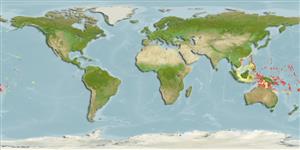Teleostei (teleosts) >
Ophidiiformes (Cusk eels) >
Dinematichthyidae (Viviparous brotula)
Etymology: Diancistrus: Greek, di = two + Greek, agkistron = hook (Ref. 45335); beateae: Named for Beate Schwarzhans.
Eponymy: Mrs Beate Schwarzhans is the first author’s wife. He wrote of her thanking her for her ‘most valuable support’ during the many years he was engaged in the study of this genus. (Ref. 128868), visit book page.
More on authors: Schwarzhans, Møller & Nielsen.
Environment: milieu / climate zone / depth range / distribution range
Ecology
Marine; reef-associated; depth range 0 - 38 m (Ref. 90102), usually 0 - 15 m (Ref. 90102). Tropical
Pacific Ocean: Micronesia, Indonesia, New Guinea, Solomons, Vanuatu Is., Fiji, Samoa, and Australia.
Size / Weight / Age
Maturity: Lm ? range ? - ? cm
Max length : 14.9 cm TL male/unsexed; (Ref. 57884); 13.2 cm SL (female)
Short description
Identification keys | Morphology | Morphometrics
Dorsal soft rays (total): 84 - 91; Anal soft rays: 65 - 74; Vertebrae: 44 - 46. Diagnosis: Vertebrae 11+33-35=44-46, dorsal fin rays 84-91, anal fin rays 65-74; eyes large (2.6-3.5% SL); outer pseudoclasper massive, hook-shaped, very broad in ventral view; inner pseudoclasper stout, fleshy, not extending over anterior rim of outer pseudoclasper; broad scale patch on cheek, large scale patch on operculum continuous above and below opercular spine (Ref. 57884).
Maximum length of 14.9 cm TL. Solitary inhabitant of coral reef crevices, cryptic (Ref 90102). Maximum length for female 13.2 SL (Ref 57884).
Life cycle and mating behavior
Maturity | Reproduction | Spawning | Eggs | Fecundity | Larvae
Schwarzhans, W., P.R. Møller and J.G. Nielsen, 2005. Review of the Dinematichthyini (Teleostei, Bythitidae) of the Indo-West-Pacific. Part I. Diancistrus and two new genera with 26 new species. The Beagle, Records of the Museum and Art Galleries of the Northern Territory 21:73-163. (Ref. 57884)
IUCN Red List Status (Ref. 130435: Version 2024-2)
Threat to humans
Harmless
Human uses
Fisheries: of no interest
Tools
Special reports
Download XML
Internet sources
Estimates based on models
Preferred temperature (Ref.
123201): 26.4 - 29.3, mean 28.6 °C (based on 1326 cells).
Phylogenetic diversity index (Ref.
82804): PD
50 = 0.5000 [Uniqueness, from 0.5 = low to 2.0 = high].
Bayesian length-weight: a=0.00389 (0.00180 - 0.00842), b=3.12 (2.94 - 3.30), in cm total length, based on all LWR estimates for this body shape (Ref.
93245).
Trophic level (Ref.
69278): 3.4 ±0.6 se; based on size and trophs of closest relatives
Fishing Vulnerability (Ref.
59153): Low vulnerability (10 of 100).
